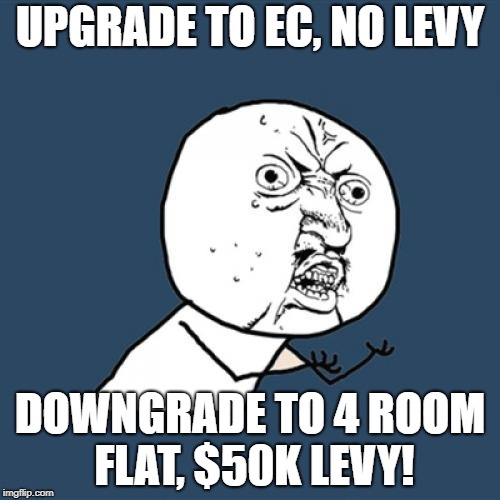I don’t know if I was one of the rare few. But on last Sunday, I watched the entire National Day Rally (in Eng) from 8:15pm to 9:30pm.
And I believe the most meaningful issue that PM Lee addressed was public housing, specifically, HDB flat’s decaying 99 years lease and what happens when it is up.
Instead of boring you with the same stuff reported by mainstream media or websites, I shall provide some hard-hitting personal insights and maybe even some recommendations of what you should do, depending on your current situation.
Hopefully, reading this post will provide good value to you, my reader.
So apologies, PM Lee, because I won’t be holding any punches back.
What PM Lee Confirmed
HDB flats will be of zero value at the end of their 99 years lease and the land will then be returned to the government for redevelopment.
In my opinion, HIP, HIP 2 and VERS are just some sweeteners to help “maintain” the value of aging flats (i.e. making sure they depreciate at a slower rate or return some/half value back to the owner) and partially appease the population who expect their flats to be SERS-ed no matter what.
5 years ago (in this post), I had already mentioned that it’s not financially viable for the government to SERS all flats in Singapore and the NDR speech justified my prediction.
PM Lee had to speak about this issue right now because in recent years, there are more and more 30-year-old couples buying flats with fewer than 70 or even 60 years left on the lease. Some of them could possibly outlive their flats in time to come.
So this is a warning to flat buyers who don’t take into account decaying land leases of older resale flats.
The Only Rational Option The Government Could Adopt
I have spoken with some peers and even financial bloggers before about the issue of decaying HDB flat leases faced by the majority of flats in Singapore by 2050. A few were upset that their HDBs were not freehold, like the houses in the US or even Taiwan.
I always feel it’s not fair to compare HDB flats with houses or apartments overseas.
Firstly, the Singapore government foots the bulk of maintenance costs for HDB flats. You don’t see that for freehold houses in other countries. Private property owners in Singapore pay for their own maintenance out of their own pocket too.
Second, land is really scarce in Singapore. Everyone wants to pass down a freehold property to their children yet hope that their grandchildren can also get a brand new BTO when they get married.
This just doesn’t gel. One can’t really have the cake and eat it too, in this instance.
Moreover, a freehold HDB flat will further exacerbate inequality. Those not lucky enough to inherit a property from their parents will be severely disadvantaged in life.
“Our society would split into property owners and those who cannot afford a property, and that would be most unequal, and socially divisive” – PM Lee
Winners Of The Singapore Property Boom
Quite rightly, the government wants to prevent segments of the future generations from becoming losers the moment they enter the property market. A 99 year lease for HDB flats definitely helps since subsidised housing can be recycled back to the population.
However, the Singapore property boom in the past 20 to 30 years has already created clear winners and realistically, they are very hard to be displaced.
Social mobility numbers in Singapore are quite good and this metric is typically measured by income even internationally. I personally think one measured by wealth would paint a more accurate picture. However, I doubt the result would be comforting to the government or society.
It’s definitely much easier to move up or down the income mobility ladder as compared to the wealth ladder, especially in a mature or maturing capitalism.
And my hunch is alot of these property wealth are in the hands of the Merdeka generation or people in their 40s or older. Honestly, I cannot really begrudge them.
They believed in the Singapore story, took some financial risk and thus, had skin in the game. So kudos to them when they end up with multiple fully paid private properties to their name, with current net worth anywhere between $5m to $20m.
Not Crazy Rich Asians money but enough to make most financial bloggers wet in their dreams. Annualised returns of 7% with the additional fuel of massive leverage really works wonders in terms of accumulating wealth.
What I am more sore with is with the outcome from regressive public housing policies some years back. One classic example below:

The above ruling has since been removed but they have already benefited two different batches of EC owners, at the expense of the masses. The Mrs and I have sort of indirectly benefited from this regressive policy, but that doesn’t stop me from calling it out.
The government really gave out an unreasonable amount of housing subsides to the aspiring middle class two to three decades ago. Case in point: HUDC flats.
Mr Lim and Mr Tan are good friends and colleagues at their work place, earning similar salaries. Both of them wanted to get married and start a family soon. Therefore, they were shopping for a flat.
This was in the 1980s.
Mr Lim and Mr Tan
Mr Lim took a liking to one of the larger HUDC units located in Serangoon/Hougang area and although the finances were a bit of a stretch, he decided to be a little more aggressive. Therefore, he bought a unit there.
Mr Tan, on the other hand, also liked the spacious HUDC units but decided to be more conservative. In the end, he purchased a new 5 room flat nearby that was about $50k cheaper.
Fast forward 35 years to 2018.
Mr Lim just pocketed $2 million after the successful enbloc of his privatised HUDC estate. After buying a relatively new resale flat in the same area, he still has enough left over for a comfortable retirement. He is also delighted that he can leave a sizable inheritance to his two children.
On the other hand, Mr Tan is worried about the value of his 5 room flat that has less than 70 years of lease left. His flat is his main nest egg and he is increasingly worried about his impending retirement, not to mention his inability to leave a financial legacy to his two children.
When you have such contrasting outcomes from the above, can you blame the man on the street from wanting to speculate to get a big payout?
If I Were A First Timer Again
What I have illustrated above is a little extreme, and entirely based on hindsight. There’s no doubt Mr Lim got very lucky, but it’s also a function of the government’s huge subsidies to move middle-class Singaporeans up the property ladder.
But that’s the past. How about now?
The cooling measures for the past 10 years, coupled with more generous housing grants, is aimed at moderating the increase in property prices and also enable first timers to get on the property ladder.
I have given two talks on “Buying Your First Home” in the past couple of years. And I am quite adamant about how first timers who can afford to wait should just stick to the ballot of BTOs.
If done right, a BTO should provide an upside of at least $150k to $200k. i.e. Buy at $400k during BTO launch and sell at $600k after MOP.
So it’s arguable that most new HDB flats are still appreciating assets, because frankly, they will appreciate in value when they reach MOP.
To me, this is the definitive perk that separates a citizen from a PR/foreigner in Singapore. For the males, it’s a meaningful financial compensation for National Service.
But of course, although this is a finance blog, I have also come to appreciate that not everyone makes decisions primarily driven by the motivation of wealth accumulation.
Some people simply cannot afford to wait and a resale flat is the only option, and rightly so. In that case, if the person can afford not to take the first timer grant, then don’t take it. That will preserve the two bites of the BTO cherry.
The exception to the rule? You expect you and your spouse to be high incomes and remain there for a long long time. Or you are high SES and perhaps a descendant of Crazy Rich Asians. But if that’s the case, why are you reading this blog?!
If I Were Stuck With An Aging Flat
If I were Mr Tan (who missed out on the HUDC windfall), I would utilise my second bite of the cherry and try for another BTO flat. This is especially so if the concerns over retirement adequacy and leaving a legacy outweigh the sentiments of staying in the matrimonial home.
In fact, yours truly tried to ballot (unsuccessfully) for the Dakota Breeze BTO project a year ago. The median price for a 4 room flat was about $550,000 and just to make my point, I expect prices to be above $800,000 after 2025 when the flat reaches its TOP.
Let’s see if my prediction is right then.
After NDR 2018, aging flats will forever be dogged by the shadow of VERS. The details of VERS are not out yet. However, two other friends/financial bloggers have written two good pieces on it (here and here).
I won’t touch too much about it because basically, I doubt VERS will be anything attractive. I will avoid it as much as possible (the urban dictionary definition would also warrant me avoiding it).
How?
I probably would have to change flats 3, 4 or even 5 times in my lifetime. Flats would just have to be sold before leases drop below 70 years and I will then just buy flats which have around 90 years of lease left.
Maximising the two bites of the BTO cherry should also help make the above happen.
P.S. I am hosting an Ask Me Anything Session on this link tonight from 8pm to 9pm. Please support!
The advantage of asking a question on the link above is that I will definitely answer or provide an opinion by this evening.

just a minor point – you said the govt pays the “bulk” of the maintenance here
but it is strange for a tenant to pay for it, especially for common facilities as well